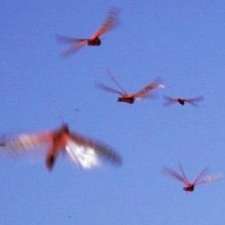Researchers use the common cockroach to fine-tune robots of the future

Ask anyone who has ever tried to squash a skittering cockroach -- they're masters of quick and precise movement. Now Tel Aviv University is using their maddening locomotive skills to improve robotic technology too.
Prof. Amir Ayali of Tel Aviv University's Department of Zoology says the study of cockroaches has already inspired advanced robotics. Robots have long been based on these six-legged houseguests, whose nervous system is relatively straightforward and easy to study. But until now, walking machines based on the cockroach's movement have been influenced by outside observations and mainly imitate the insect's appearance, not its internal mechanics.
He and his fellow researchers are delving deeper into the neurological functioning of the cockroach. This, he says, will give engineers the information they need to design robots with a more compact build and greater efficiency in terms of energy, time, robustness and rigidity. Such superior robotics can be even used to explore new terrain in outer space.
This research was recently presented at the International Neuroethology conference in Spain as well as the Israeli Neuroscience Meeting in December.
Roach control systems as the ideal model
According to Prof. Ayali, it's clear why robotics have been inspired by these unsavory insects. A cockroach is supported by at least three legs at all times during movement, which provides great stability. "Not only do cockroaches arguably exhibit one of the most stable ways to walk, called a tripod gate," he explains, "but they move equally quickly on every kind of terrain. Their speed and stability is almost too good to be true."
In their lab, Prof. Ayali and his fellow researchers are conducting a number of tests to uncover the mysteries of the cockroach's nervous system, studying how sensory feedback from one leg is translated to the coordination of all the other legs. Their analysis of the contribution of each leg is shared with collaborating scientists at Princeton University, who use the information to construct models and simulations of insect locomotion.
Insects, says Prof. Ayali, utilize information from the environment around them to determine how they will move. Sensors give them data about the terrain they are encountering and how they should approach it. How this information transfers to the insect's legs is central to understanding how to mimic their locomotion.
An army of robotic insects
Cockroaches are not the only insects that have captured the scientific imagination. Projects that highlight both the flight of the locust and the crawling of the soft-bodied caterpillar are also underway.
Locusts are amazing flyers, Prof. Ayali notes. Scientists are studying both their aerodynamic build and their energy metabolism for long-distance flights. Recordings of their nervous systems and simultaneous video tracking to observe the movement of their wings during flight can be expected to lead to better technology for miniscule flying robots.
As for caterpillars, engineers are trying to recreate in soft-bodied robots what they call the creatures' "endless degrees of freedom of movement." "Caterpillars are not confined by a stiff structure — they have no rigid skeletons," says Prof. Ayali. "This is exactly what makes them unique."
Provided by Tel Aviv University




















